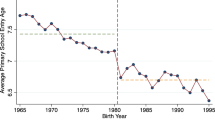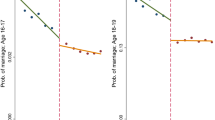Abstract
Objectives
We analyze the impact of adolescent motherhood on several education and labor market outcomes in Chile over the 1990–2013 period. We explore whether effects are different across income levels, timing of adolescent births, and three sub-periods.
Methods
Using the CASEN national household survey, we applied propensity score-matching methods on two samples of women aged 24: one for women in the 2009–2013 period and another sample of 24-year-old women living with their mother between 1990–2013.
Results
In both samples, adolescent motherhood has negative effects on educational outcomes (high school completion, enrollment in technical institutes and universities, and years of education) and on labor outcomes of non-poor women. Childbearing in early adolescence is associated with worse outcomes, and the adverse effects of adolescent motherhood on education and labor outcomes have diminished over the period.
Conclusions
Similar to results in developed countries, adolescent motherhood has negative consequences on women’s education and labor outcomes, particularly on women that become mothers early in adolescence. Public policies aimed at reducing teen motherhood will have important effects on young women’s education and employment.
Similar content being viewed by others
References
Abadie A, Imbens GW (2006) Large sample properties of matching estimators for average treatment effects. Econometrica 74:235–267
Arceo-Gomez EO, Campos-Vazquez R (2014) Teenage pregnancy in Mexico: evolution and consequences. Latin Am J Econ 51:109–146. doi:10.7764/LAJE.51.1.109
Ashcraft A, Fernández-Val I, Lang K (2013) The consequences of teenage childbearing: consistent estimates when abortion makes miscarriage non-random. Econ J 123:875–905
Assini-Meytin LC, Kerry M (2015) Long-term consequences of adolescent parenthood among African-American Urban youth: a propensity score matching approach. J Adolesc Health 56:529–535
Azevedo JP, Favara M, Haddock SE, Lopez-Calva LF, Muller M, Perova E (2012) Teenage pregnancy and opportunities in Latin America and the Caribbean: on teenage fertility decisions, poverty and economic achievement. World Bank, Washington, DC
Bassi M, Busso M, Muñoz JS (2013) Is the Glass Half Empty or Half Full? School Enrollment, Graduation, and Dropout Rates in Latin America. IDB Working Paper No. IDB-WP-462
Becker G (1981) A treatise on the family. Cambridge, Mass.: Harvard University Press
Berthelon M, Kruger D (2011) Risky behavior among youth: incapacitation effects of school on adolescent motherhood and crime in Chile. J Public Econ 95:41–53
Blackburn ML, Bloom DE, Neumark D (1993) Fertility timing, wages, and human capital. J Popul Econ 6:1–30
Buvinic M (1998) The costs of adolescent childbearing: evidence from chile, barbados, guatemala and Mexico. Stud Fam Plann 29:201–209
Casas L, Ahumada C (2009) Teenage sexuality and rights in Chile: from denial to punishment. Reprod Health Matter 17:88–98
Chevalier A, Viitanen TK (2003) The long-run labour market consequences of teenage motherhood in Britain. J Popul Econ 16:323–343
Cornia GA (2014) Falling inequality in latin America: policy changes and lessons. Oxford University Press, Oxford New York
Fletcher J, Wolfe BL (2009) Education and labor market consequences of teenage childbearing: evidence using the timing of pregnancy outcomes and community fixed effects. J Hum Resour 44:303–325
Geronimus AT, Korenman S (1992) The socioeconomic consequences of teen childbearing reconsidered. Q J Econ 107:1187–1214
Gibb SJ, Fergusson DM, Horwood LJ, Boden JM (2014) Early motherhood and long-term economic outcomes: findings from a 30-year longitudinal study. J Res Adolescence 25:163–172
Guzman JM, Hakkert R, Contreras JM, Falconier de Moyano M (2001) Diagnóstico sobre salud sexual y reproductiva de adolescentes en América Latina y el Caribe. Fondo de Población de las Naciones Unidas, Equipo de Apoyo Técnico del UNFPA para América Latina y el Caribe, México, D.F
Heckman JJ, Ichimura H, Todd P (1998) Matching as an econometric evaluation estimator. Rev Econ Stud 65:261–294
Hofferth SL, Reid L, Mott FL (2001) The effects of early childbearing on schooling over time. Fam Plann Perspect 33:259–267
Hoffman SD (1998) Teenage childbearing is not so bad after all.or is it? A review of the new literature. Fam Plann Perspect 30:236–243
Hoffman SD, Foster EM, Furstenberg FF Jr (1993) Reevaluating the costs of teenage childbearing. Demography 30:1–13
Hotz VJ, McElroy SW, Sanders SG (2005) Teenage childbearing and its life cycle consequences exploiting a natural experiment. J Hum Resour 40:683–715
Imbens GW, Angrist D (1994) Identification and estimation of local average treatment effects. Econometrica 62:467–475
Kahn JR, Anderson KE (1992) Intergenerational patterns of teenage fertility. Demography 29:39–57
Klepinger D, Lundberg S, Plotnick R (1999) How does adolescent fertility affect the human capital and wages of young women? J Hum Resour 34:421–448
Lee D (2010) The early socioeconomic effects of teenage childbearing: a propensity score matching approach. Demogr Res 23:697–736
Levine DI, Painter G (2003) The schooling Costs of teenage out-of-wedlock Childbearing: analysis with a within-school propensity-score-matching Estimator. Rev Econ Stat 85:884–900
Manacorda M, Sanchez-Paramo C, Schady N (2010) Changes in returns to education in latin America: the role of demand and supply of skills. Ind Labor Relat Rev 63:307–326. doi:10.1177/001979391006300207
Marteleto L, Lam D, Ranchhod V (2008) Sexual behavior, pregnancy, and schooling among young people in urban South Africa. Stud Fam Plann 39:351–368
Ribar D (1994) Teenage fertility and high school completion. Rev Econ Stat 76:413–424
Rico MN, Trucco D (2014) Adolescentes: derecho a la educación y al bienestar futuro. CEPAL-UNICEF, Santiago
Rosenbaum P, Rubin DB (1983) The central role of the propensity score in observational studies for causal effects. Biometrika 70:41–55
Rosenbaum P, Rubin DB (1985) Constructing a control group using multivariate matched sampling methods that incorporate the propensity score. The American Statistician 39(1):33–38
Rubin DB (1973) The use of matched sampling and regression adjustment to remove bias in observational studies. Biometrics 29:185–203
Rubin DB, Thomas N (2000) Combining propensity score matching with additional adjustments for prognostic covariates. J Am Stat Assoc 95:573–585
Singh S (1998) Adolescent childbearing in developing countries: a global review. Stud Fam Plann 29:117–136
Stuart EA, Rubin DB (2007) Best practices in quasi-experimental designs: matching methods for causal inference. Chapter 11 in best practices in quantitative social Science. J. Osborne (Ed.) Thousand Oaks, CA: Sage Publications, pp 155–176
Timæus IM, Moultrie TA (2015) Teenage childbearing and educational attainment in South Africa. Stud Fam Plann 46:143–160. doi:10.1111/j.1728-4465.2015.00021.x
Upchurch DM, McCarthy J (1990) The timing of a first birth and high school completion. Am Sociol Rev 55:224–234
Urdinola BP, Ospino C (2015) Long-term consequences of adolescent fertility: the Colombian case. Demogr Res 32:1487–1518
Acknowledgements
This research was supported by Chile’s Comisión Nacional de Investigación Científica y Tecnológica (CONICYT), through FONDECYT Grant Nos. 1070447, 1120882, and 11080088. The authors would like to thank Melanie Oyarzun for her diligent research assistance, two anonymous referees for their comments, as well as comments received from seminar participants at the Universidad de Chile, Pontificia Universidad Católica de Chile and Universidad Alberto Hurtado. All errors and omissions are responsibility of the authors.
Author information
Authors and Affiliations
Corresponding author
Electronic supplementary material
Below is the link to the electronic supplementary material.
Rights and permissions
About this article
Cite this article
Berthelon, M., Kruger, D.I. Does adolescent motherhood affect education and labor market outcomes of mothers? A study on young adult women in Chile during 1990–2013. Int J Public Health 62, 293–303 (2017). https://doi.org/10.1007/s00038-016-0926-5
Received:
Revised:
Accepted:
Published:
Issue Date:
DOI: https://doi.org/10.1007/s00038-016-0926-5




